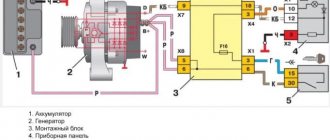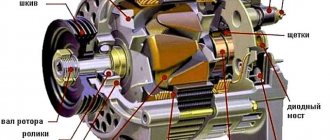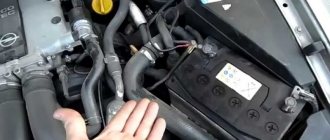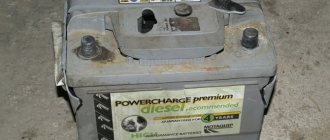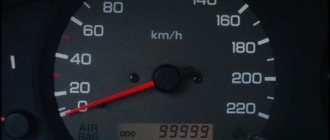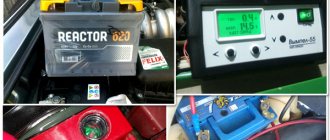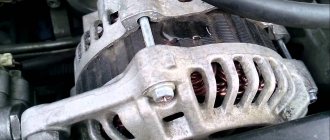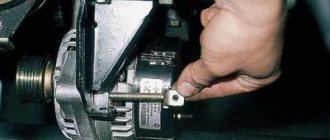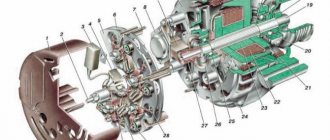Problems with battery charging are indicated by a red battery indicator on the dashboard. If you see a charging icon on the dashboard, check the actual voltage level in the on-board network. Let's talk not only about generator malfunctions, but also about cases when the battery is not charged from the charger. Let's look at the causes and signs of plate sulfation and short circuit inside the battery.
How to check the network voltage on a car?
To measure charging, use a multimeter in DC current (DCV) mode. To find out exactly why the battery failed to charge, several methods are used to measure the voltage of the on-board network. Types of checks by connection type:
- measuring the voltage at the battery terminals. The multimeter probes are connected directly to the positive and negative terminals of the battery. The test shows the actual voltage of the on-board network;
- measuring the voltage at the generator output. The negative probe (COM) is connected to the negative terminal of the battery, and the positive one to terminal 30 of the generator (the wire with the largest cross-section is suitable for it). This connection allows you to measure the charge level without taking into account the losses due to overcoming the internal resistance of the positive wire from the generator to the battery, the connection point between the unit housing and the negative terminal of the battery.
The difference in readings should not exceed 0.1-0.3 V. A significant difference indicates parasitic resistance in the generator connection circuit.
To find out the cause of the difference, you need to connect one of the multimeter probes to terminal 30 of the generator, and the second to the positive terminal of the battery. The multimeter reading is the actual voltage loss at the ends of the conductor. If the readings are equal or very close to the voltage difference when measured at the battery terminals and from the output, it means there is a loss at the connection between terminal 30 of the generator and the battery. Otherwise, the problem should be looked for in the connection of the negative wire from the battery to the car body, as well as in the section of flexible mass from the body to the engine.
Do not forget about the possible loss of voltage at the battery connection terminals. Oxides on the inner surface, as well as loose terminals, will cause the battery to not charge completely.
Verification steps
Generator diagnostics are carried out in two stages.
- Measurements with switched off consumers. Test conditions: fully charged battery, vehicle idling. The voltage should be between 14-14.8 V.
- Measurements with consumers turned on. Test conditions: fully charged battery, the car is idling, the maximum number of powerful electrical consumers is turned on (heater fan, wipers, high beams, heated rear window, etc.). The purpose of the test is to load the generator as much as possible to check the charge level at peak consumption. The voltage should not drop below 13.8-14.3 V.
Let's sum it up
Problems with voltage in the on-board network arise quite often. Motorists may not even know that their car has electrical problems. The problem is visible only if it has reached the final stage and begins to affect the operation of the devices. But even a drop in the network voltage by 0.2V from the normal factory value can cause permanent battery failure and problems with a decrease in the efficiency of the headlight. If your car has such problems, it is worth visiting a good electrician and having it repaired before these manifestations become fatal.
And if in old domestic cars the on-board electrical network could work with 10V voltage, then in modern foreign cars a slight deviation from the standard causes real problems. But the cost of restoring an expensive modern car is quite high. And not every electrician can take on this job. It is extremely expensive to contact the official service. Choose the method of treating the problem that is optimal for you, since it is not worth continuing to operate a vehicle with such a problem. This will become a big problem and cause significant trouble in the near future. Have you ever had problems with voltage in your car electrical network?
The battery is not charging, what is the reason?
A problem with charging the battery may be due to a malfunction of the generator or due to improper operation of the charging control system. Main generator failures:
- Broken pulley (rotates independently of the rotor).
- Loss of contact between the current-collecting brushes and the rotor commutator. Occurs due to critical wear of the brushes, depletion of the working surface of the rotor contact rings, and freezing of the brush pressure springs.
- Voltage regulator malfunction.
- Internal short circuit of the stator winding.
- Failure of the rectifier bridge.
- Short circuit of the rotor winding.
- Slipping of the generator belt due to low tension, oil getting on the working surface, and destruction of the bearings.
The simplest charging control system consists of an excitation circuit that includes a wire and a light on the dashboard. If the red light on the instrument cluster display does not light up, and the battery is not charging from the generator, diagnostics should begin by checking the excitation circuit.
In other design options, in addition to the excitation circuit, a wire is connected through the light bulb to the generator, on which a “+” should appear after the ignition is turned on. Often this circuit is protected by a separate fuse, so if it blows, the battery also does not charge. If the voltage in the excitation circuit is sufficient and all the necessary signals are received by the unit, the cause is a faulty generator.
Generator check
The reason why the battery is not charging may be that the generator is not working. If the car has a high mileage, this can lead to wear out of the rotor or wear of the rotating elements. As a result, this can lead to misalignment of parts inside the structure and lack of rotation. If the generator is jammed, it will need to be replaced; repairs in this case will not yield results. In addition, the reason may be a broken circuit inside the mechanism. Such a malfunction can only be identified with the help of an electrician.
In general, most problems associated with lack of charge can be solved on your own. To do this, you just need to properly monitor the operation of the unit and devote time to diagnosing the battery and generator if the corresponding indicator appears on the device.
Why won't the battery charge?
Let's say you find out that the generator is working, but the car battery is not charging. Most often, this occurs due to irreversible physical and chemical reactions inside the battery case, which arise as a result of improper operation, mechanical damage, or age-related depletion of the resource. Among such malfunctions are:
- plate sulfation;
- internal short circuit of one of the sections;
- critical decrease in electrolyte density. This occurs not only during natural evaporation of the distillate during active use of the battery, but also due to unqualified maintenance. Trying to add distilled water can reduce the density of the electrolyte so much that the battery will no longer be charged from the generator or from a conventional charger. You can measure the density of the electrolytic liquid with a hydrometer.
If your car's battery does not charge from the alternator, but takes charge from an external power source, carefully inspect the inside of the battery terminals. A dense layer of oxides increases resistance, which is why the car battery is constantly undercharged.
Sulfation of plates
The plates are coated with a layer of lead sulfate, which reduces the capacity and increases the internal resistance of the battery. Accelerated sulfation occurs when the battery is stored in a discharged state for a long time. During normal operation, the process of plate sulfation is accelerated by increased density, low level and high temperature of the electrolyte. Heating and boiling of the electrolytic liquid occurs when the battery is charged with a high current from the charger, as well as when operating a car with a faulty generator (overcharging).
The critical level of sulfation cannot be reversed - the battery will have to be replaced. In the early stages, the process can be stopped by several charge-discharge cycles with control of the electrolyte density.
The extent of the problem can be assessed by visual inspection of the plates, as well as by the density and transparency of the electrolytic liquid. A battery with deep surface sulfation begins to boil very quickly when an external power source is connected, but does not take a charge. At the same time, the density of the electrolyte increases slightly, which is why the battery has difficulty or does not start the engine at all, even after charging with an external device.
Internal short circuit
A car battery consists of 6 compartments, inside of which there is a package of multi-polar lead plates. They are immersed in electrolytic liquid and should not come into contact with each other. A short circuit occurs when the battery case is deformed or when the active mass falls off. Large particles can get stuck between the plates, causing an internal short. Signs of a closed section:
- the battery loses charge. Even after being fully charged, the battery cannot start the engine;
To avoid buying a new battery by mistake, first check the current leakage level on your car. Perhaps the cause of the malfunction is not at all the melting of the active mass and short circuit of the plates.
- stepwise reduction in voltage of a charged battery. In a 12-volt system, the battery is divided into 6 sections connected in series. The sum of the voltages of each section (2.15 V) is the total charge of a fully charged battery - 12.7 V. If the voltage at the battery terminals after charging does not increase more than 10.1-11.2 V, one of the sections has an internal short circuit;
- no response to charging. When charging a serviced battery, the electrolyte begins to boil over time, indirectly indicating a full charge. If you do not hear the characteristic boiling sound from one of the service holes, most likely the can has an internal short circuit;
- convexity of the body. Often the problem section can be identified by the deformation zone of the housing.
The charger does not see the battery
If the battery does not charge when you connect an external charger, you should measure the voltage at the battery terminals. To supply current to the battery, many chargers need to register a certain minimum voltage at the battery terminals. In other words, the power supply does not see that its terminals are connected to the battery, and therefore does not start the charging process.
To get out of this situation, you will need an additional battery (charge not lower than 10 V) and two wires. To start the charging process, with the device connected, it is enough to connect the positive terminals of the batteries with one wire, and the negative terminals with the second. The charger will register the load and begin charging the battery, after which the wires can be disconnected.
Winding break
If the excitation winding is broken, then there is no charging of the battery. To determine this, it is often enough to place your hand on the generator. When it breaks, it heats up. For an accurate check, you need to disconnect the end of the excitation winding from the brush, connect the battery wires to it, and connect the battery wires to terminal Ш of the generator (via a voltmeter or a light bulb).
If there is a break, the voltmeter needle will not deflect and the light bulb will not light up. To find which of the coils prevents the generator from working, connect the wires from the battery to each individually. Finally, check the soldering and coil terminals. If the break is internal, the coil needs to be replaced; for external ones, soldering helps.
